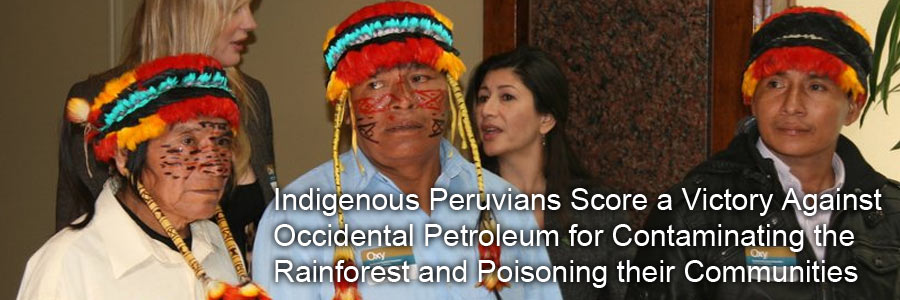Oxy's Oil Disaster in Block 1AB
Thirty-five years of oil production in Block 1-AB in the northern Peruvian Amazon have left the Achuar, Urarina and Quechua indigenous peoples who live in the area suffering malnutrition, sickness and social disruption. Successive oil companies – first US-based Occidental Petroleum (Oxy) and now Argentina's Pluspetrol – have been pumping oil in the concession known as Block 1-AB since the early 1970's. Until very recently, flagrant pollution has been the norm. Oxy's legacy of harm continues to be felt: the company's reckless operations illegally dumped approximately 9 billion barrels of "produced waters" – which contain highly toxic substances such as barium, lead and arsenic – throughout 30 years of operations (averaging 850,000 barrels dumped per day).
The companies polluted for decades, lowering their production costs and maximizing return for their shareholders. Local people, however, have paid the costs. Adults and local children have tested positive for dangerously high blood-lead levels, and local residents cite countless tales of unexplained diseases, tumors, skin ailments and miscarriages from oil exposure. Fish and local game are not fit for consumption and fraught with contamination, and the soil is also no longer fit to produce the agricultural crops on which the Achuar depend for subsistence.
Today, the area is peppered with legacy toxic waste sites left from Oxy's operations that continue to leach into the rivers and the food chain. Pluspetrol took over Block 1-AB and neighboring Block 8 in 2000, but problems continue. While the company has made a commitment to improve certain practices, dozens of oil spills every year continue to contaminate lakes and rivers and serious health problems persist in the affected communities.
Public Health Crisis in the Corrientes
"We no longer have any places to fish. We stopped fishing in our lake, because once when we ate fish from the lake, everyone got sick with nausea, diarrhea and other, incurable diseases. Five men died." Indigenous leader, Pucacuro community
The Achuar, Urarina, Quechua and other indigenous peoples of the region depend on clean forest and river resources for subsistence. But after 35 years of reckless practices, falling below the industry standards of the time, these resources have suffered extensive and near-irreversible damage. In 1984, the Peruvian government's National Office of Natural Resource Evaluation (Oficina Nacional de Evaluacion de Recursos Naturales, or ONERN) declared Block 1-AB to be "the country's most damaged environmental region." According to several recent reports, local waterways and sediments are severely contaminated with elevated levels of salinity, heavy metals including lead and barium, and hydrocarbons and associated toxic compounds. The dumping of produced waters has decimated local vegetation and, together with oil spills, contaminated agricultural areas. As a result, indigenous families must either eat contaminated fish and crops or move their farms to less productive areas.
In addition to the lack of uncontaminated food, many communities have no springs or alternatives sources of water and are forced to drink polluted river water. Affected communities are suffering from severe health impacts from exposure to oil-related contaminants. As a result of Oxy and Pluspetrol's illegal practices, the Achuar of the Corrientes are facing a serious public health crisis. Several studies have discovered that the Achuar are suffering from elevated levels of the toxic heavy metals lead and cadmium in their blood, both of which can cause significant negative health impacts. According to one study, a significant proportion of children tested in every affected community show a blood-lead level above the relevant health standard. Similarly, a study by the Peruvian government in the seven affected communities revealed that all but two of the 199 people tested showed blood-cadmium levels above the standard.
The costs of oil drilling have far outweighed any benefits for the Achuar of the Corrientes, and they remain some of the most neglected communities in Peru. Oil blocks 1-AB and 8 represent Peru's largest oil facility and generate nearly 50% of Peru's domestic oil production, yet state provision of basic services such as schools and health posts is limited or non-existent in this area. With the degradation of the forests, hunting and fishing grounds, local people struggle to feed their families, and they have few opportunities to earn money to buy necessary supplies.









